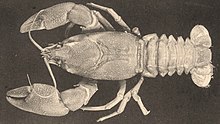
Crayfish are freshwater crustaceans belonging to the clade Astacidea, which also contains lobsters. In some locations, they are also known as baybugs, crabfish, craws, crawfish, crawdaddies, crawdads, freshwater lobsters, mountain lobsters, mudbugs, rock lobsters, signal crawfish, or yabbies. Taxonomically, they are members of the superfamilies Astacoidea and Parastacoidea. They breathe through feather-like gills. Some species are found in brooks and streams, where fresh water is running, while others thrive in swamps, ditches, and paddy fields. Most crayfish cannot tolerate polluted water, although some species, such as Procambarus clarkii, are hardier. Crayfish feed on animals and plants, either living or decomposing, and detritus.

Astacus is a genus of crayfish found in Europe and western Asia, comprising three extant (living) species and three extinct fossil species.

Cambaroides japonicus, also known as Japanese crayfish, is a species of crayfish endemic to Japan.

The signal crayfish is a North American species of crayfish. It was introduced to Europe in the 1960s to supplement the North European Astacus astacus fisheries, which were being damaged by crayfish plague, but the imports turned out to be a carrier of that disease. The signal crayfish is now considered an invasive species across Europe, Japan, and California, ousting native species there.

The European mink, also known as the Russian mink and Eurasian mink, is a semiaquatic species of mustelid native to Europe.

Astacus astacus, the European crayfish, noble crayfish, or broad-fingered crayfish, is the most common species of crayfish in Europe, and a traditional food source. Like other true crayfish, A. astacus is restricted to fresh water, living only in unpolluted streams, rivers, and lakes. It is found from France throughout Central Europe, to the Balkan Peninsula, and north as far as Scandinavia and Finland, and Eastern Europe. Males may grow up to 16 cm long, and females up to 12 cm.

Pacifastacus is a genus of crayfish native to western North America, containing six species, two of which are extinct:

Astacidae is a family of freshwater crayfish native to Europe and western North America. The family is made up of four extant (living) genera: The genera Astacus, Pontastacus, and Austropotamobius are all found throughout Europe and parts of western Asia, while Pacifastacus is found on the Pacific coast of the United States and British Columbia and includes the signal crayfish and the Shasta crayfish.

Pacifastacus fortis is an endangered crayfish species endemic to Shasta County, California, where it is found only in isolated spots on the Pit River and Fall River Mills. The exact subpopulations for the Shasta Crayfish were discovered in 2004 through a genetic study that determined three different genetic clusters: Crystal Lake, the Big Lake group, and Thousand Springs.

Austropotamobius pallipes is an endangered European freshwater crayfish, and the only crayfish native to the British Isles. Its common names include white-clawed crayfish and Atlantic stream crayfish.

The Western pond turtle, also known commonly as the Pacific pond turtle is a species of small to medium-sized turtle in the family Emydidae. The species is endemic to the western coast of the United States and Mexico, ranging from western Washington state to northern Baja California. It was formerly found in Canada, but in May 2002, the Canadian Species at Risk Act listed the Pacific pond turtle as being extirpated.

The Owens pupfish is a rare species of fish in the family Cyprinodontidae, the pupfish. It is endemic to California in the United States, where it is limited to the Owens Valley. It is a federally listed endangered species of the United States. This pupfish is up to 5 centimetres long, the largest males sometimes longer. The male is blue-gray, turning bright blue during spawning. The female is greenish brown with a silvery or whitish belly.

Austropotamobius torrentium, also called the stone crayfish, is a European species of freshwater crayfish in the family Astacidae. It is mostly found in tributaries of the Danube, having originated in the northern part of the Balkan Peninsula.

Cambarus bartonii is a species of crayfish native to eastern North America, where it is called the common crayfish or Appalachian brook crayfish.

Faxonius immunis is a species of crayfish in the family Cambaridae. It is native to North America and it is an introduced species in Europe, where it lives along the Upper Rhine. Its common names include calico crayfish and papershell crayfish.
Aenigmastacus crandalli is a species of fossil freshwater crayfish. It was found in early Eocene Okanagan Highlands lake deposits in British Columbia, and was described in 2011. It is the first member of the Gondwana-distributed family Parastacidae to be found in the Northern Hemisphere, and is the only species in the genus Aenigmastacus. Twelve specimens are known, with a total body length of 3–5 cm (1.2–2.0 in). On some specimens, details of the internal anatomy can be seen due to the exceptional preservation.

Procambarus natchitochae, or the Red River creek crayfish, is a crayfish native to the Red River basin and Bayou Teche in Texas, Louisiana, and Arkansas. Its distribution is given by the IUCN here, whereas a slightly different Louisiana map is provided in the "Crawfishes of Louisiana", which excludes Bayou Teche P. natchitochae has a distribution of approximately 46,000 km2.
Faxonius maletae, sometimes called the Kisatchie painted crayfish or Kisatchie painted crawfish, is a species of crawdad in the Cambaridae family. The specific epithet maletae is in honor of the discoverer's wife, author Maleta M. Walls, who helped collect many of the original specimens. It was originally described as a subspecies of Orconectes difficilis, but later elevated to full species status. The common name refers to the Kisatchie National Forest, near where the original specimens were found in Bayou Santabarb.

Euastacus yanga, also known as the variable spiny cray, is a freshwater crayfish endemic to south eastern Australia.

















